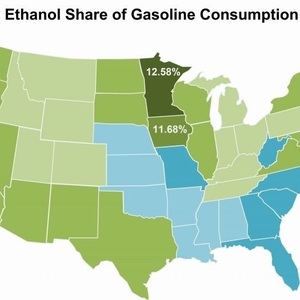RFA: Ethanol “blend wall” demolished in 2021

January 20, 2023
BY Renewable Fuels Association
As higher ethanol blends like E15 and E85 continued to expand in the marketplace in 2021, thirty-five states and the District of Columbia blasted through the so-called 10 percent ethanol “blend wall,” according to data released today from the U.S. Energy Information Administration. Minnesota and Iowa led the way in 2021, with ethanol accounting for 12.6 percent and 11.6 percent, respectively, of statewide gasoline consumption. California, Texas, and 12 other states had an average ethanol blend rate near 10.7 percent. The national average ethanol blend rate reached a record 10.32 percent in 2021, according to the data.
“The state-level data released by EIA today should finally put to rest any lingering myths and misinformation about the fictitious ethanol blend wall,” said Renewable Fuels Association President and CEO Geoff Cooper. “American drivers in all 50 states clearly want more fuel options, and lower-cost, lower-carbon ethanol proved itself once again in 2021. As leaders in the marketing of E15 and E85, it’s no surprise that Minnesota and Iowa came out on top in 2021. Those states are showing the rest of the nation what is possible when you take proactive steps to provide more consumer options at the pump.”
When 2022 nationwide data ethanol consumption data is finalized in February, it will show even further growth in ethanol’s share of America’s gas tanks, Cooper said. Last November, EIA released an analysis of high blend rates in the summer months that noted the U.S. ethanol blend rate hit a record summer average of 10.5 percent in 2022 and averaged 10.6 percent in June and August. “Fuel ethanol’s price discount to gasoline was one factor that led to the higher summer blend rate in 2022,” the report stated. “Although ethanol prices have been high in 2022, they have been low relative to gasoline prices, which were at their highest since 2014 this summer because of low domestic inventories and constraints on refining capacity.”
Advertisement
Advertisement
Related Stories
Phillips 66 on July 25 released Q2 financial results, reporting the company’s Rodeo Renewable Energy Complex in California continues to run at reduced rates due to market conditions. Pre-tax income for the renewables segment was up when compared to Q1.
The EIB and Eni on July 24 signed a €500 million 15-year finance contract to support the conversion of Eni’s Livorno refinery in Tuscany, Italy, into a biorefinery that can produce renewable diesel, renewable naphtha and bio-LPG.
Iowa Secretary of Agriculture Mike Naig announced that the Iowa Renewable Fuels Infrastructure Program Board recently approved an additional 24 applications from Iowa fuel retailers to support new and expanded biofuel infrastructure projects.
CountryMark on July 22 celebrated the completion of more than $100 million in upgrades at its refinery in Indiana, including those related to soybean oil storage. The facility produces renewable diesel via coprocessing technology.
ATOBA Energy and Air Moana are partnering to implement scalable solutions for the supply of SAF. The collaboration aims to ensure long-term SAF availability while supporting local initiatives to develop sustainable fuel production in Tahiti.
Upcoming Events










